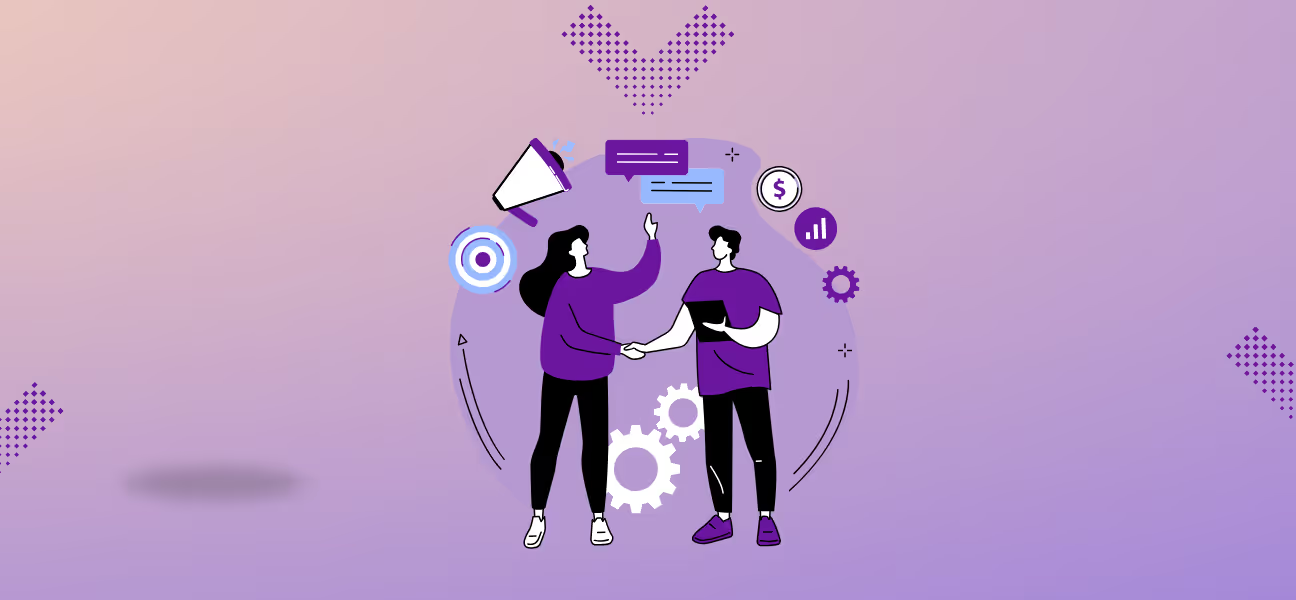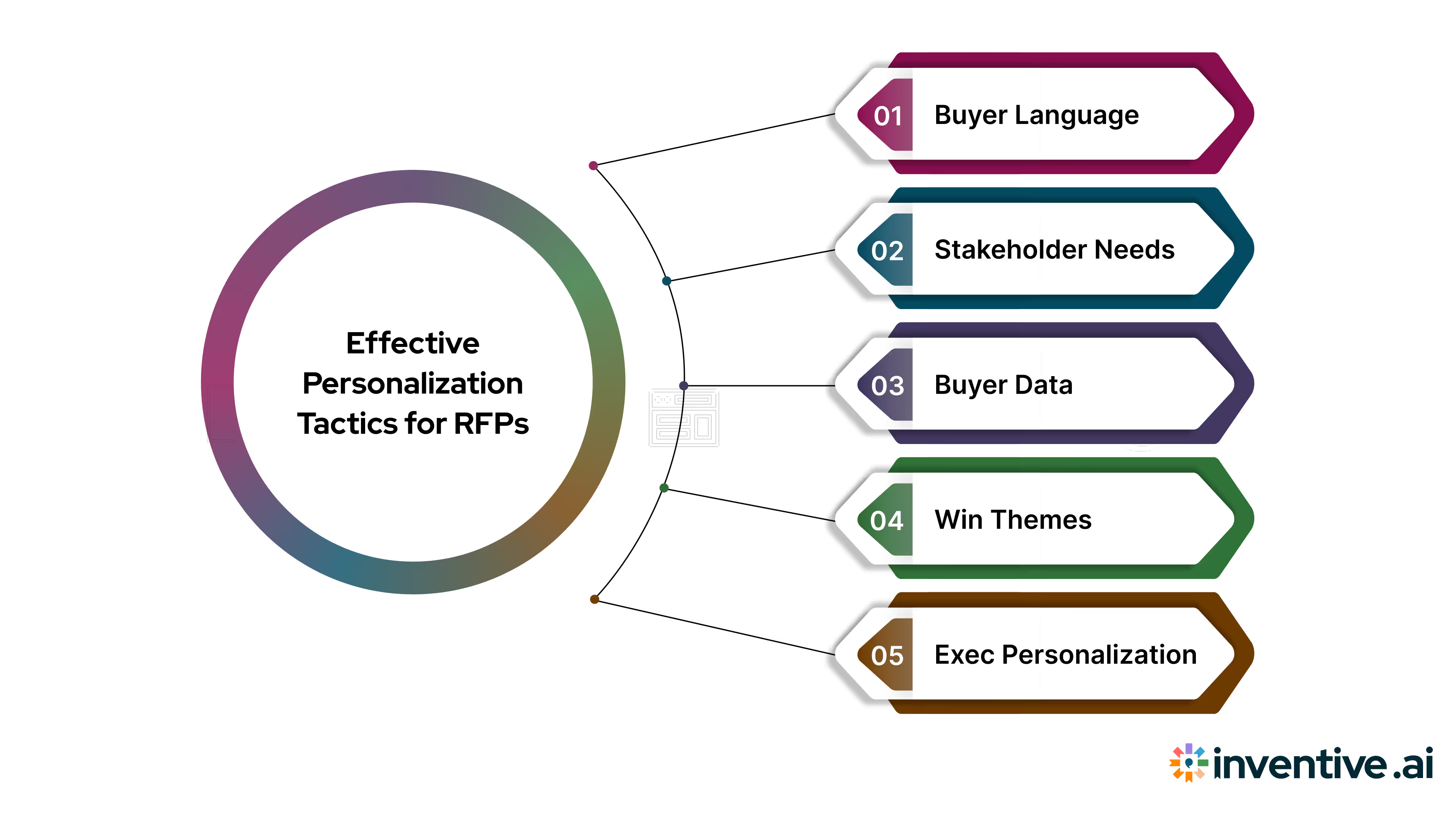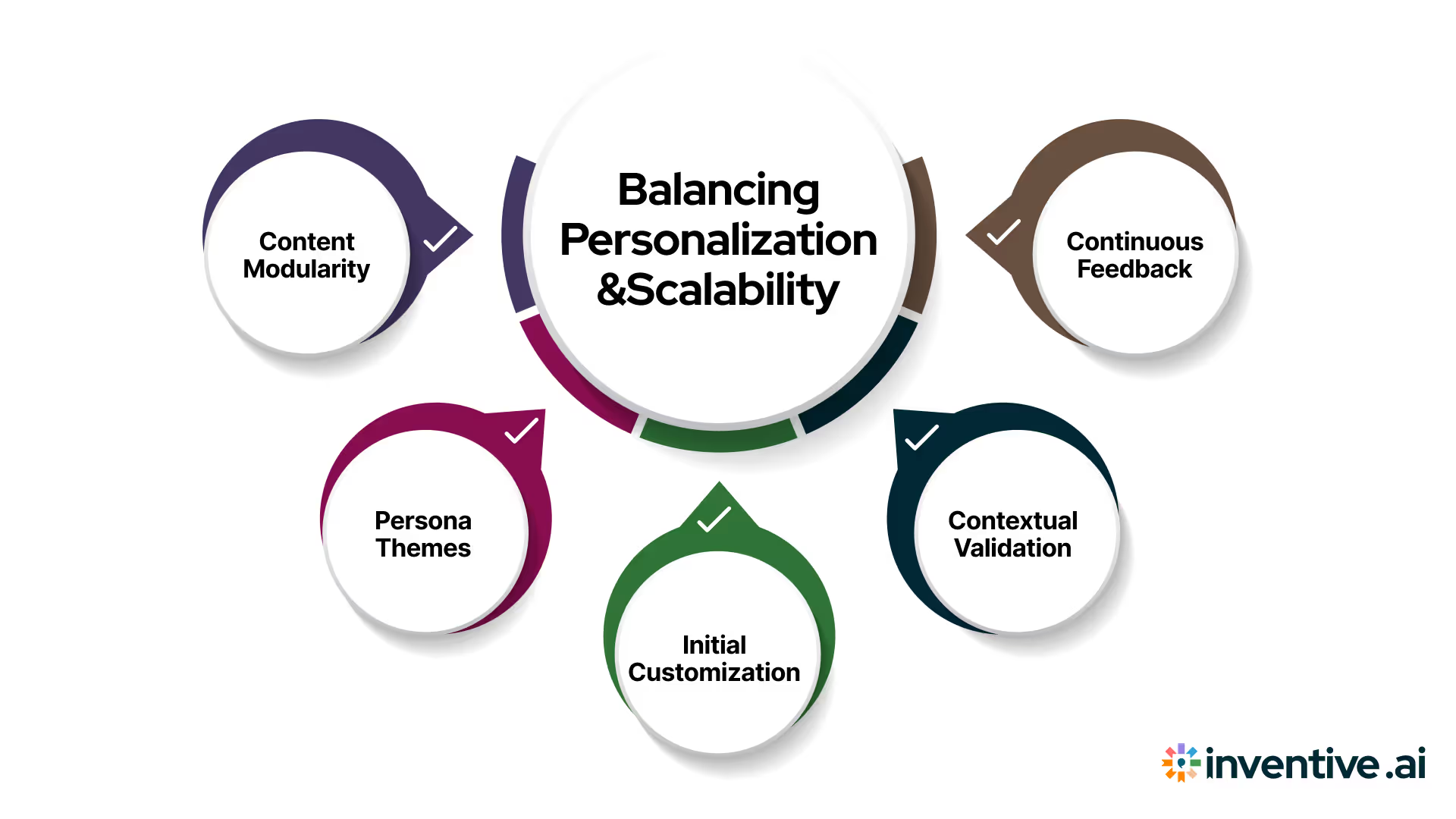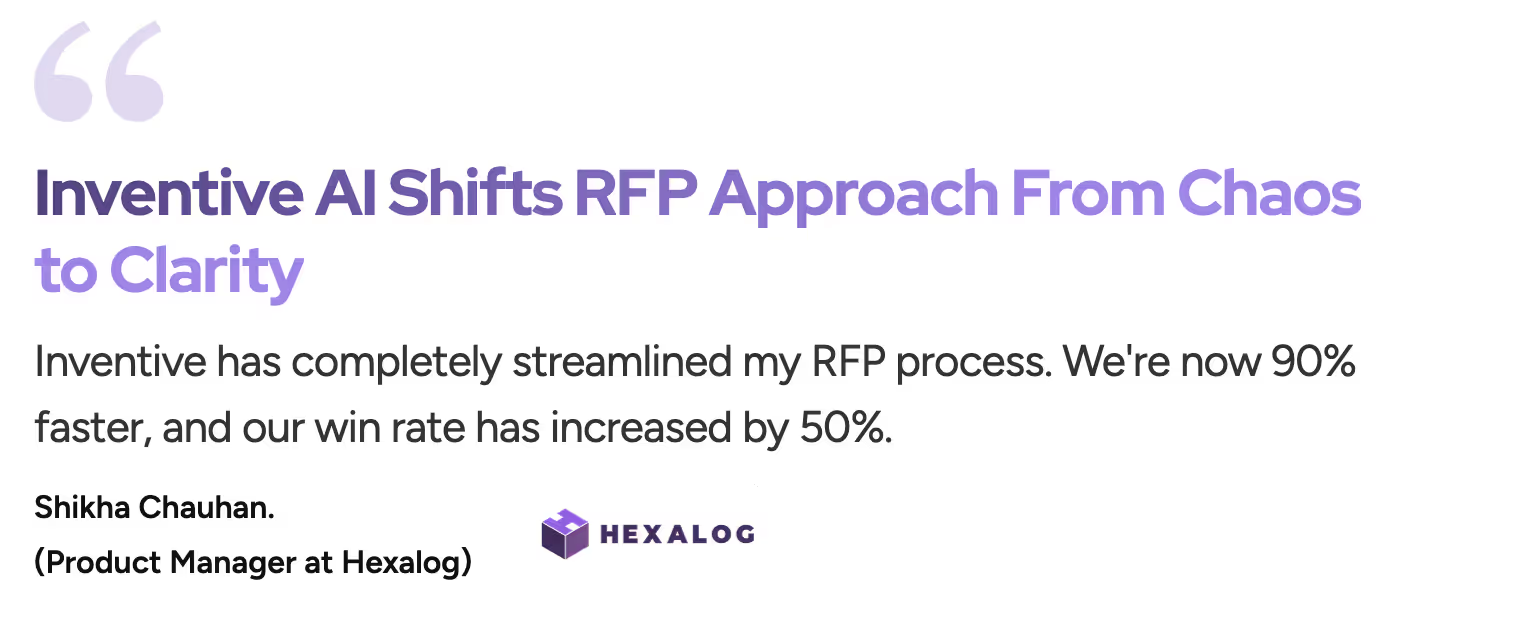Integrating Personalization into Your RFP Strategy
Boost proposal success through integration RFP content personalization. Research deeply, tailor to needs, align with brand, use AI tools. Enhance now!

In 2025, decision-makers aren’t just comparing prices, they’re evaluating how well vendors understand their needs, challenges, and goals. B2B buyers expect relevance, not repetition.
We understand that managing multiple complex RFPs under tight deadlines while trying to personalize responses can feel overwhelming and time-consuming.
53% of B2B buyers say that personalization drives revenue growth.
Yet most RFP responses still rely on outdated templates and generic answers that fail to connect with what buyers actually care about. That’s where personalized, insight-driven responses become a true differentiator, especially when executed at scale using AI.
This blog explores how the integration of RFP content personalization helps boost win rates, engage evaluators, and create responses that truly resonate.
TL;DR
- Generic RFP responses don’t cut it. 53% of B2B buyers say personalization drives revenue, and evaluators expect tailored solutions that reflect their goals and language.
- From segmenting templates by industry and tailoring summaries to inserting buyer-relevant case studies and visuals, personalization must be baked into every layer of your response.
- Personalized RFPs lead to up to 45% higher win rates, faster shortlisting, and smarter content reuse across proposals.
- Personalisation isn’t optional, it’s the strategic edge. Teams of all sizes can scale tailored, high-impact RFP responses and win more deals, faster.
What is RFP Content Personalisation?
RFP content personalization means more than just inserting a client’s name into a proposal. It’s the process of tailoring your responses, both technically and contextually, to reflect the specific goals, challenges, and decision-making criteria of each buyer.
In manufacturing, logistics, healthcare, and tech, where RFPs are often dense and highly regulated, personalization involves mapping your value proposition to the client's industry pain points, aligning technical language to buyer knowledge levels, and responding with use cases that mirror their operations.
Done right, personalization communicates three things:
- You’ve done your homework.
- You understand their problem.
- Your solution fits, not just broadly, but precisely.
However, personalization at scale is hard. Especially when your team is juggling multiple RFPs, tight deadlines, and fragmented content libraries. That’s where automation, powered by AI, becomes essential, not just to save time but to make personalization replicable and repeatable across every proposal.
Knowing what personalisation entails is just the start, now, it’s equally important to understand why sticking to generic responses is no longer a viable option in today’s RFP landscape.
Why Generic RFP Responses Fail in 2025?
In 2025, vendors must stand out in a crowded marketplace where procurement teams are overwhelmed with proposals, and generic responses fail to make an impact. A boilerplate answer doesn’t just reduce your chances of winning the bid; it signals a lack of effort, insight, and fit.
Here’s why generic responses are costing vendors deals:
- They ignore client-specific priorities. Buyers want to see their unique goals, use cases, and KPIs reflected in your response, not just a laundry list of features.
- They don’t differentiate your offering. In crowded markets like logistics, SaaS, or healthcare services, a generic response looks identical to five others. Without relevance, you’re invisible.
- They fail to address stakeholder needs. Most RFPs go through cross-functional review, legal, technical, operations, finance. A one-size-fits-all response won’t answer the nuanced questions each of these teams has.
- They increase friction. When buyers have to dig through vague content to understand your value, they’re more likely to pass you over.
In short, generic RFP responses waste everyone’s time, yours and the buyer’s. That’s why leading vendors are moving toward scalable personalization, and AI RFP agents like Inventive AI are powering that shift.
So, how can you put personalization into practice and make it repeatable? Let’s walk through actionable strategies to infuse personalization across your entire RFP workflow.
How to Integrate Personalisation in Your RFP Response?
Generic proposals don’t win competitive bids, tailored ones do. Personalizing your RFP response shows the buyer that you understand their business, their pain points, and their desired outcomes. It’s more than changing the company name or logo, true personalisation weaves your value proposition into the customer’s context.
Here are actionable ways to integrate personalisation into every layer of your RFP strategy:
1. Segment Your Proposal Templates by Industry or Use Case
A one-size-fits-all proposal template is no longer enough. Develop multiple templates aligned to each key industry or buyer persona you serve, education, logistics, healthcare, manufacturing, etc.
Example: If your solution serves both K–12 districts and higher ed institutions, use distinct templates that reflect their unique vocabulary, compliance needs (FERPA vs. HIPAA), and priorities.
2. Address Stakeholders by Role and Priority
Most RFPs are reviewed by committees. Instead of writing to a generic audience, tailor specific sections for each stakeholder group, IT, finance, procurement, and operations.
Example: Include a separate “IT Integration Summary” for tech reviewers, and a “Cost Efficiency Breakdown” for finance teams. Inventive AI allows you to tag content by stakeholder relevance for quicker targeting.
3. Mirror the Buyer’s Language and Tone
Use the same terminology, acronyms, and phrasing found in the original RFP to increase relevance and boost rubric alignment; Inventive AI automates this by detecting contextual cues and adjusting your response tone accordingly.
Example: If a university RFP says “student outcomes,” don’t use “learning metrics”, reflect their language exactly.
4. Add a Personalised Cover Letter or Executive Summary
Your summary is your first impression. Go beyond the boilerplate and call out the buyer’s specific goals and how your solution addresses them.
Example: “Based on your strategic priority to reduce onboarding time by 40% across satellite campuses, our implementation team will…” is far more compelling than a generic greeting.
5. Include Buyer-Relatable Visuals
Use photos, diagrams, or dashboards that reflect the buyer’s environment. Visuals can help the evaluator imagine your solution in their context.
Example: For a school district, show a visual of your LMS dashboard populated with sample student data. For a logistics client, include a real-time shipment tracking UI.
6. Surface Relevant Case Studies by Sector or Region
Showcase past success stories that are highly similar to the buyer’s context, same industry, geography, or challenge.
Example: “When working with Smith County School District, we helped digitize their curriculum planning process in under 45 days, resulting in a 98% staff adoption rate.” This offers credibility and relatability.
7. Customise Your Value Proposition
Avoid using your generic pitch. Instead, position your features as direct solutions to the RFP’s stated challenges.
Example: If the RFP states a need for “multi-site deployment,” emphasize your “distributed rollout module,” not just your product’s scalability.
8. Personalise Attachments and Appendices
Even supporting documents like pricing breakdowns, SLAs, or timelines should reflect the buyer’s environment.
Example: Tailor your implementation timeline to the district’s semester calendar or the company’s fiscal year-end planning window.
9. Use Dynamic Content Tools
Modern RFP tools like Inventive AI can auto-personalise sections based on industry, role, and proposal history, reducing manual work while maintaining a high level of specificity.
Example: The platform can insert pre-approved case studies or compliance templates dynamically based on selected RFP metadata (like “cybersecurity + higher education + Northeast region”).
10. Reinforce with Post-Submission Follow-Up
Personalization shouldn’t stop at submission. Include follow-up materials, like a short video message or use-case explainer, tailored to the client’s evaluation team.
Example: Send a 3-minute recorded walkthrough showing how your onboarding portal aligns with the buyer’s training timeline.
These foundational steps are crucial, but which personalization tactics actually drive results? Here are five high-impact methods backed by industry insights and platform capabilities.
5 Personalisation Tactics That Actually Work in RFPs

To win high-value contracts, you need more than just accurate responses, you need responses that resonate. Below are five proven personalization tactics that elevate your RFPs from generic to compelling:
1. Mirror the Buyer’s Language
Use the same terminology, acronyms, and formatting the buyer uses in their RFP document. This creates alignment and shows attention to detail. Inventive AI automates this by detecting contextual cues and adjusting your response tone accordingly.
2. Address Stakeholder-Specific Needs
RFPs are reviewed by multiple stakeholders, IT, legal, procurement, operations. A single response won’t satisfy them all. Inventive AI maps questions to stakeholder concerns and helps you tailor content that appeals to each reviewer’s priorities.
3. Insert Buyer-Specific Data
Reference buyer pain points, market conditions, or case study outcomes relevant to their industry. With Inventive AI, you can pull in curated success stories and metrics tied to similar clients, without digging through old folders.
4. Customise Win Themes
Don’t rely on boilerplate differentiators. Inventive AI’s dynamic “Win Themes” highlight your strengths based on buyer evaluation criteria, whether it’s speed of implementation, regulatory readiness, or integration capabilities.
5. Personalise the Executive Summary
This is your narrative hook. A customized summary that reflects the buyer’s strategic goals, not just your offerings, sets the tone for the rest of the proposal. Inventive AI helps generate a tailored first draft by analysing the RFP intent and buyer profile.
Ready to personalize at scale? See how Inventive AI helps you craft tailored, high-impact proposals that resonate with every evaluator. Book a demo and elevate your RFP win strategy today →
Still wondering if the extra effort is worth it? Let’s take a look at the numbers that show how personalization directly impacts RFP success metrics.
Metrics That Prove Personalisation Drives Results
If personalization sounds like extra work, here’s the truth: it pays off. In a competitive RFP landscape where buyers evaluate more than just price, tailored responses are often the tie-breaker.
Higher Win Rates with Personalised Proposals
B2B companies using personalized proposals see an increase in win rates compared to those using generic templates. Why? Because buyers recognize when vendors take time to align with their goals, values, and pain points.
Faster Shortlisting with Relevant Content
Buyers spend less time deciphering proposals that mirror their language. According to Forrester, Nearly 90% of decision-makers prefer vendors who demonstrate a clear understanding of their business, deliver proven value, and serve as trusted industry experts. Personalization speeds up evaluation and helps your proposal stand out fast.
Content Engagement Signals That Predict Outcomes
Using Inventive AI’s built-in analytics, proposal managers can track which content modules, case studies, proof points, win themes, are most frequently reused and most often present in winning bids. This helps teams refine their personalization efforts based on data, not guesswork.
Smarter Content Reuse Drives Efficiency
Teams using Inventive AI’s AI-Powered RFP Response Software report up to 70% content reuse across personalised responses. That means less time creating new material and more time refining key sections to match what each buyer values most.
Personalization works, but doing it at scale requires a smarter approach. Here’s how top-performing teams maintain quality while handling volume.
Best Practices to Balance Personalisation and Scalability

Customizing every RFP from scratch isn’t sustainable, but generic responses won’t win deals either. The key is to find the right balance: personalize where it matters most and scale using AI where appropriate. Here’s how top-performing proposal teams do it:
1. Start with Modular, Reusable Content
Don’t reinvent the wheel for every proposal. Build a centralized content library with modular sections, like company overviews, service descriptions, and case studies that can be quickly customized per client. With Inventive AI, your content stays organised, version-controlled, and easily searchable.
2. Define Buyer Personas and Themes
Use data from past wins to create detailed buyer profiles. Understand what each persona values, cost savings, compliance, innovation, etc., and tag your responses accordingly. Inventive AI helps you align content suggestions with decision-maker priorities using built-in tagging and win theme tracking.
3. Personalise the First 20%
Focus your personalization efforts on the opening summary, key differentiators, and value proposition. This is where buyers form first impressions. Let AI handle repetitive or technical sections, and reserve human input for the moments that drive engagement.
4. Use AI to Insert Contextual Proof
Rather than manually inserting relevant proof points, use Inventive AI to surface contextual case studies, metrics, and past project examples based on the RFP topic or industry. This creates a stronger connection without extra research time.
5. Maintain a Feedback Loop
Track which personalized elements lead to wins. Inventive AI’s built-in analytics reveal which messaging themes and modules correlate with success, so your team can refine personalization efforts based on results, not assumptions.
Achieving personalization at scale might sound complex, but with the right tools, it becomes efficient and repeatable. Here’s how Inventive AI simplifies and strengthens your RFP personalization strategy.
How Inventive AI Helps Integrate Personalisation in RFP Strategy?
Tailoring your RFP responses to each buyer’s needs used to mean more hours, more manual edits, and more back-and-forth across teams. But in 2025, personalisation is no longer optional, buyers expect proposals that speak their language, reflect their industry, and show you understand their pain points from the first page.
Inventive AI is purpose-built to make personalization faster, easier, and scalable across teams. Here’s how it works:
Context-Aware Drafting With AI RFP Agent
Inventive AI is the only RFP platform that delivers truly contextualized responses. Its AI RFP Agent analyzes each proposal’s structure, terminology, and buyer intent to generate first drafts that mirror the tone, language, and priorities of the evaluator. Whether it’s a government transportation bid, a compliance-heavy pharma contract, or a SaaS-driven supply chain integration, your responses are tailored to resonate with the reviewer. During trials, users reported that Inventive AI’s contextual drafts were 50% more relevant and accurate compared to leading RFP AI tools—giving teams a measurable edge in both quality and evaluator perception.
Smart Content Retrieval From a Central Knowledge Base
The platform tags your past responses, proof points, and case studies by industry, product, region, and buyer persona, making it easy to auto-suggest the most relevant content for every RFP. No more digging through folders or sending Slack messages to find that one great answer.
Real-Time Proof Point Suggestions
From security certifications to implementation timelines, Inventive AI locates and inserts the right evidence from your content library and systems like SharePoint, email threads, and past proposals, without slowing your team down.
Dynamic Templates With Buyer-Specific Fields
Proposal teams can build reusable templates with dynamic fields that auto-populate client-specific details like name, objectives, geography, and stakeholders, ensuring every response feels personalized, not generic.
Cross-Team Coordination, Without Chaos
Assign sections, request SME input, and track edits across departments, all within one platform. Inventive AI keeps version control, deadlines, and approvals aligned, so your personalization efforts never get buried in spreadsheets or emails.
Built-In Analytics to Track Personalisation Impact
Understand what’s working. Inventive AI tracks performance by industry, buyer type, and proposal section, helping you refine messaging and optimize future responses based on what actually wins deals.


Here’s why this matter for your RFP personalisation strategy -
- 90% faster responses with AI-generated, personalized first drafts tailored to each RFP.
- Up to 45% higher win rates by aligning responses with client-specific goals and evaluation criteria.
- Smarter content reuse using AI to surface relevant case studies, stats, and messaging instantly.
Inventive AI helps you personalize proposals at scale without burning out your sales, proposal, or solution teams. Whether you're responding to five RFPs or fifty, the platform ensures every proposal feels like it was written for that one buyer. Book a demo today>>
Conclusion
In 2025, personalization isn’t just a nice to have; it’s the difference between being shortlisted and being overlooked. But true personalization at scale requires more than templates or last-minute edits. It demands intelligent automation, centralized knowledge, and a system built to adapt to every buyer every time.
Inventive AI’s integration of RFP content personalization empowers your sales, proposal, and solutions teams to deliver targeted, high-scoring responses faster and with greater precision. From understanding buyer context to surfacing the right proof points, Inventive AI turns every proposal into a strategic advantage.
Ready to personalize every RFP without slowing down? Discover how Inventive AI helps you cut response time by up to 90%, increase win rates by over 50%, and scale your proposal process without the chaos. Book your personalized demo today.
FAQs
1. Can smaller teams or startups personalize at scale without a full proposal department?
Absolutely. With centralized content libraries and AI-generated drafts, even lean teams can produce highly personalized proposals. Inventive AI enables smaller organisations to compete with enterprise-level bid volume and quality.
2. What sections of an RFP should I personalize first if I’m short on time?
Focus on the executive summary, win themes, and value proposition first. These are the most visible and emotionally resonant parts of your proposal. Personalizing these sections helps you make a strong first impression, even if other technical responses remain more templated.
3. How does AI determine what content to personalize in a proposal?
AI platforms like Inventive AI analyse the RFP’s language, buyer profile, and past response data to suggest personalized content blocks, such as relevant case studies, compliance proof points, or stakeholder-specific answers, based on what has worked for similar deals.


